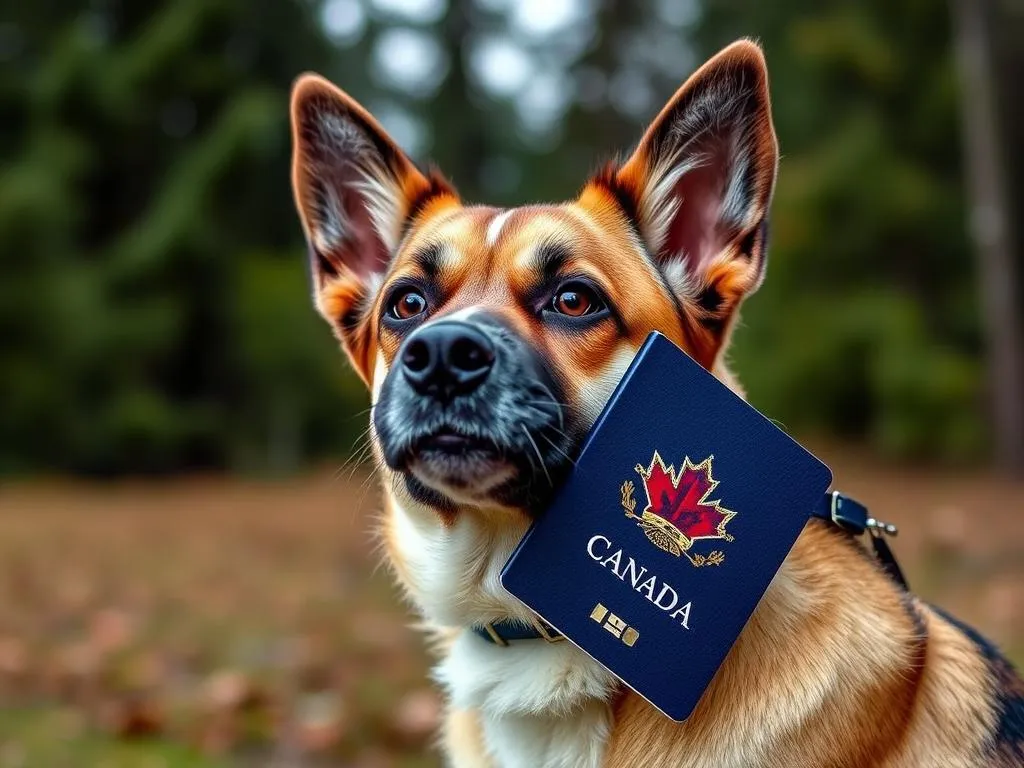
Traveling with pets is an adventure that many pet owners cherish, but it requires careful planning and the right documentation. One of the essential documents needed for this journey is a Canadian pet passport. This guide will walk you through the importance of having a pet passport, the steps to obtain one, and how to prepare for travel with your furry friends.
Understanding the Canadian Pet Passport
Definition of a Pet Passport
A pet passport is a set of documents that provide proof of a pet’s identity, health, and vaccination status. It typically contains vital information such as the pet’s microchip number, vaccination records, and a health certificate issued by a licensed veterinarian. Unlike other pet travel documents, a pet passport is specifically designed to facilitate smooth travel across borders, ensuring that your pet meets the entry requirements of different countries.
Benefits of Having a Pet Passport
Having a Canadian pet passport offers several advantages:
- Ease of Travel Across Borders: With a pet passport, you can simplify the process of traveling with your pet, making it easier to cross borders without unnecessary delays.
- Simplified Entry Requirements: Many countries have specific entry requirements for pets. A pet passport can help you meet these requirements quickly.
- Importance for Pet Health and Safety: A pet passport includes health documentation that ensures your pet is fit for travel, helping prevent any health issues while abroad.
Eligibility Criteria for Pets
Types of Pets Covered
The Canadian pet passport generally covers common pets like dogs and cats. However, some exotic pets may also qualify, but they often have unique requirements that must be met. Always check the specific regulations for your pet type before planning your travel.
Health Requirements
To be eligible for a Canadian pet passport, pets must meet certain health requirements:
- Vaccination Records: Pets, especially dogs and cats, need to have up-to-date vaccinations, including the rabies vaccine, which is mandatory for international travel.
- Veterinary Check-Ups: A health certificate from a licensed veterinarian is essential. This certificate confirms that your pet is healthy and free from contagious diseases.
- Age and Breed Considerations: Some countries have age restrictions for pets traveling. Additionally, certain breeds may face specific regulations due to health concerns.
Step-by-Step Guide to Obtaining a Canadian Pet Passport
Preparing for the Process
Before you begin the application process for a Canadian pet passport, it is essential to gather all necessary information about your pet. This includes your pet’s name, breed, age, and microchip number. Additionally, finding a certified veterinarian who can assist you with the required health documentation is crucial.
Obtaining a Microchip
Microchipping your pet is an important step in the pet passport process. A microchip provides a permanent form of identification, helping reunite you with your pet in case they get lost.
- Importance of Microchipping Pets: Many countries require pets to be microchipped before entry for identification purposes.
- Microchip Registration Process: After microchipping, ensure that your pet’s microchip is registered with your contact information in a recognized database.
Vaccination Requirements
Different pets have varying vaccination needs, but the following are generally required for a Canadian pet passport:
- Rabies Vaccine: This vaccine is mandatory for dogs and cats and must be administered at least 21 days before travel.
- Other Vaccinations: Depending on the destination, other vaccines (such as distemper or parvovirus for dogs) may also be necessary.
Completing the Pet Passport Application
Once you have gathered all necessary information, you can start filling out the application for a Canadian pet passport.
- Where to Obtain the Application Form: Application forms are typically available through your veterinarian or online from government resources.
- Information Required in the Application: You will need to provide details about your pet, including their microchip number, vaccination history, and the veterinarian’s information.
- Tips for Filling Out the Application Accurately: Double-check all information for accuracy, as any discrepancies can delay processing.
Submitting the Application
After completing the application, you will need to submit it for processing:
- How to Submit the Application: Depending on your region, you may have the option to submit the application online, by mail, or in person at a designated office.
- Fees Associated with the Application Process: There are usually fees associated with obtaining a Canadian pet passport, which can vary based on the services you require.
- Expected Processing Times: Processing times can vary, so it’s advisable to apply well in advance of your planned travel date.
Preparing for Travel with Your Pet
Travel Arrangements
When planning to travel with your pet, consider the following:
- Choosing Pet-Friendly Transportation Options: Look for airlines or trains that have specific pet policies in place. Ensure they accommodate your pet’s needs during the journey.
- Booking Pet-Friendly Accommodations: Research and book accommodations that allow pets, ensuring they meet your pet’s needs for space and comfort.
Packing for Your Pet
Properly packing for your pet is essential to ensure their comfort during travel. Here are some items you should consider bringing:
- Essential Items: Include food, water, a travel bowl, bedding, toys, and any medications your pet may need.
- Preparing for Different Climates and Environments: Pack accordingly based on your destination’s climate to ensure your pet stays comfortable.
Safety and Comfort During Travel
To ensure a smooth journey for your pet, consider these tips:
- Tips for Keeping Your Pet Calm and Comfortable: Familiarize your pet with their travel carrier and provide them with toys or blankets that have familiar scents.
- How to Handle Pet Emergencies While Traveling: Research veterinary services in your travel area in advance. Carry a basic first aid kit for your pet to address minor issues.
Traveling Internationally with Your Pet
Understanding International Requirements
When traveling internationally with your pet, it’s crucial to be aware of the specific requirements of your destination. Each country has different regulations regarding pet entry, so thorough research is necessary to avoid complications.
Re-entering Canada with Your Pet
When returning to Canada with your pet, ensure you have the following documentation ready:
- Documentation Required Upon Return: You will need to present your pet’s Canadian pet passport, vaccination records, and health certificates.
- Customs Regulations for Pets: Be aware of the customs regulations that apply to bringing pets back into Canada, which may include specific declarations or inspections.
Common Challenges and Solutions
Health Issues
Traveling can pose health risks for pets, especially those with pre-existing conditions. Here’s how to manage these challenges:
- Dealing with Pre-existing Health Conditions: Consult your veterinarian before traveling to ensure your pet is fit for the journey and discuss any necessary precautions.
- Finding a Veterinarian Abroad: Research veterinary services in your destination area ahead of time for emergencies.
Behavioral Challenges
Pets can experience anxiety during travel. Consider these strategies:
- Addressing Travel Anxiety in Pets: Gradually acclimate your pet to their carrier and practice short trips to reduce anxiety.
- Training Tips for Travel Readiness: Basic obedience training can help your pet feel more comfortable and secure during travel.
Documentation Issues
Occasionally, documentation issues can arise. Here’s how to handle them:
- What to Do If You Lose Your Pet Passport: If you lose your passport, contact your veterinarian immediately to obtain a new health certificate and follow up with the relevant authorities for replacement.
- Handling Discrepancies in Documentation: If there are discrepancies in your pet’s documentation, contact your veterinarian for assistance in correcting any errors.
Conclusion
Having a Canadian pet passport is essential for smooth and stress-free travel with your pet. It not only ensures compliance with international travel regulations but also prioritizes your pet’s health and safety. Start the process early to avoid last-minute rushes, and prepare thoroughly for a wonderful travel experience with your beloved companion. Safe travels!









